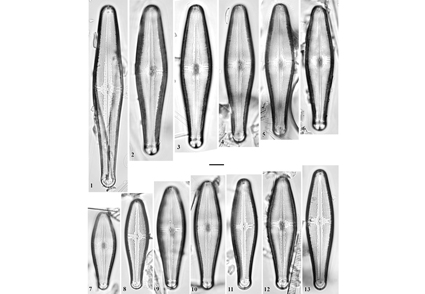Abstract
This note describes a new record of Gomphonema firmum Skvortzow, which expanded both morphological and distributional ranges of the species. This conspicuous diatom was previously unknown outside of Lake Baikal, where it inhabits deep-water areas. The newly discovered locality belongs to a small stream at a distance of 180 km west from Lake Baikal, where the species was found in a relatively high abundance that enabled to trace a size diminution series including specimens shorter than previously described. In addition, G. lanceolatum var. maximum Poretzky, a name for a diatom from Lake Teletskoe, was included in a synonymy of G. firmum that further expanded the species distribution. In the light of the presented data, the species appears to be a rare diatom with current distribution limited to a few scattered localities in southern Siberia.
References
Bondarenko, N.A. & Genkal, S.I. (2005) On the records of Lake Baikal endemic algae in mountains lakes of Zabaikalye. Botanicheskii Zhurnal 90 (9): 1389–1401.
Ehrenberg, C.G. (1832) Über die Entwickelung und Lebensdauer der Infusionsthiere; nebst ferneren Beiträgen zu einer Vergleichung ihrer organischen Systeme. Abhandlungen der Königlichen Akademie Wissenschaften zu Berlin, Physikalische Klasse 1831: 1–154.
Ehrenberg, C.G. (1843) Verbreitung und Einfluss des mikroskopischen Lebens in Süd- und Nord-Amerika. Abhandlungen der Königlichen Akademie der Wissenschaften zu Berlin 1841: 291–445.
Flower, R.J. (2005) A review of diversification trends in diatom research with special reference to taxonomy and environmental applications using examples from Lake Baikal and elsewhere. Proceedings of the California Academy of Sciences 56 (11): 107–128.
Genkal, S.I. & Bondarenko, N.A. (2006) Are the Lake Baikal diatoms endemic? Hydrobiologia 568 (S): 143–153. https://doi.org/10.1007/s10750-006-0321-y
Krammer, K. & Lange-Bertalot, H. (1986) Bacillariophyceae, 1. Teil: Naviculaceae. In: Ettl, H., Gerloff, J., Heynig, H. & Mollenhauer, D. (Eds.) Süsswasserflora von Mitteleuropa. Band 2/1. Gustav Fischer Verlag, Jena, pp. 1–876.
Kulikovskiy, M. & Kociolek, J.P. (2014) The diatom genus Gomphonema Ehrenberg in Lake Baikal. I. Morphology and taxonomic history of two endemic species. Nova Hedwigia, Beiheft 143: 507–518. https://doi.org/10.1127/1438-9134/2014/027
Kulikovskiy, M.S., Glushchenko, A.M., Genkal, S.I., Kuznetsova, I.V. & Kociolek, J.P. (2020) Platebaikalia – a new monoraphid diatom genus from ancient Lake Baikal with comments on the genus Platessa. Fottea, Olomouc 20: 58–67. https://doi.org/10.5507/fot.2019.014
Kulikovskiy, M.S., Lange-Bertalot, H., Metzeltin, D. & Witkowski, A. (2012) Lake Baikal: hotspot of endemic diatoms. I. Iconographia Diatomologica. Annotated diatom micrographs 23: 7–608.
Levadnaja, G.D. (1973) Species nova et rarae Bacillariophytorum in flumine Enissej. Novosti sistematiki nizshikh rastenii 10: 18–21.
Levkov, Z. (2009) Amphora sensu lato. Diatoms of Europe: Diatoms of the European inland waters and comparable habitats 5: 5–916.
Mats, V.D. (1993) The structure and development of the Baikal rift depression. Earth-Science Reviews 34 (2): 81–118. https://doi.org/10.1016/0012-8252(93)90028-6
Metzeltin, D. & Lange-Bertalot, H. (2014) The genus Didymosphenia M. Schmidt. A critical evaluation of established and description of 11 new taxa. Iconographia Diatomologica. Annotated diatom micrographs 25: 1–293.
Pomazkina, G., Rodionova, Ye., Sherbakova, T. & Williams, D.M. (2016) Petroplacus gen. nov. (Bacillariophyta): a new genus of diatom from Lake Baikal. Phytotaxa 272: 267–276. https://doi.org/10.11646/phytotaxa.272.4.4
Pomazkina, G.V., Rodionova, E.V. & Sherbakova, T.A. (2019) Validation of 123 names of new diatom taxa from Lake Baikal. Limnology and Freshwater Biology 1: 181–198. https://doi.org/10.31951/2658-3518-2019-A-1-181
Poretzky, V.S. & Sheshukova, V.S. (1953) Diatomovye Teletskogo ozera i svyazannykh s nim rek. In: Proschkina-Lavrenko, A.I. & Sheshukova, V.S. (Eds.) Diatomovyi sbornik. Izdatelstvo Leningradskogo Universiteta, Leningrad, pp. 107–172.
Proschkina-Lavrenko, A.I. (Ed.) (1950) Diatomovyi Analiz. Kniga 3. Opredelitel iskopaemykh i sovremennykh diatomovykh vodoroslei. Poryadok Pennales. Gosgeolitizdat, Leningrad, 398 pp. 117 pls.
Reichardt, E. (1995) Die Diatomeen (Bacillariophyceae) in Ehrenbergs Material von Cayenne, Guyana Gallica (1843). Iconographia Diatomologica 1: 1–99.
Rodionova, Y., Pomazkina, G. & Sherbakova, T. (2019) Three new diatom species of the genus Diploneis (Bacillariophyta) from Lake Baikal. Diatom Research 34 (2): 95–108. https://doi.org/10.1080/0269249X.2019.1620339
Skabitschewsky, A.P. (1963) Vodorosli nekotorykh vodoemov okrestnostei Irkutska. In: Galaziy, G.I. (Ed.) Issledovaniya po mikroflore i zooplanktonu Baikala (Trudy Limnologicheskogo Instituta 22). Izdatelstvo Akademii nauk SSSR, Moscow, Leningrad, pp. 48–62.
Skabitschewsky, A.P. (1984) Species Gomphonematis Ag. (Bacillariophyta) Lacus Baical. Novosti sistematiki nizshikh rastenii 21: 51–62.
Skvortzow, B.W. & Meyer, K.I. (1928) A contribution to the Diatoms of Baikal Lake. Proceedings of the Sungaree River Biological Station 1 (5): 1–55.
Skvortzow, B.W. (1937) Bottom diatoms from Olhon Gate of Baikal Lake, Siberia. Philippine Journal of Science 62 (3): 293—377.
The INTAS Project 99-1669 Team (2002) A new bathymetric map of Lake Baikal. Open-File Report on CD-Rom.
Usoltseva, M., Kopyrina, L., Titova, L., Morozov, A., Firsova, A., Zakharova, Y., Bashenkhaeva, M., Maslennikova, M. & Likhoshway, Y. (2020) Finding of a putative Lake Baikal endemic, Lindavia minuta, in distant lakes near the Arctic pole in Yakutia (Russia). Diatom Research 35 (2): 141–153. https://doi.org/10.1080/0269249X.2020.1747551
Vishnyakov, V.S. & Romanov, R.E. (2015) Typification of the name Gomphonema popovae (Bacillariophyceae). Botanicheskii Zhurnal 100 (4): 382–388. https://doi.org/10.1134/S0006813615040067


